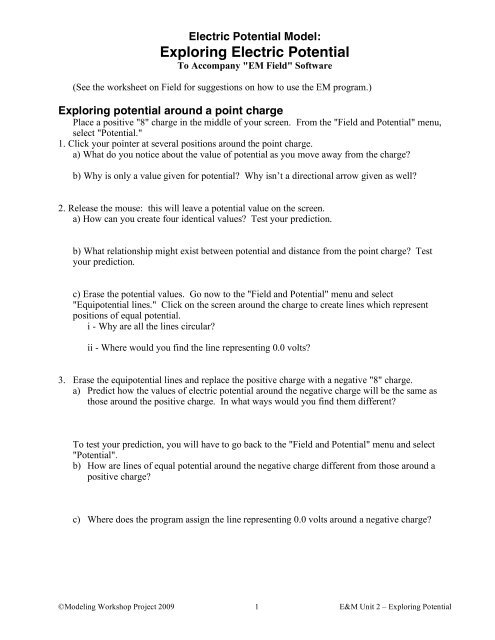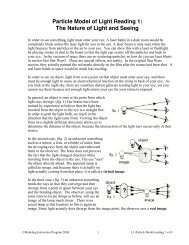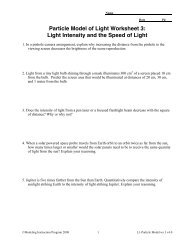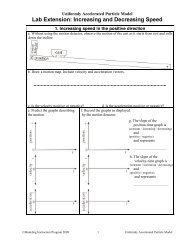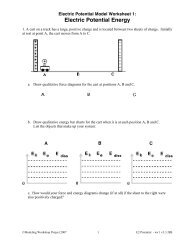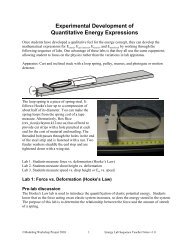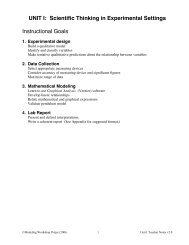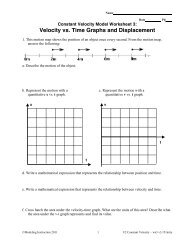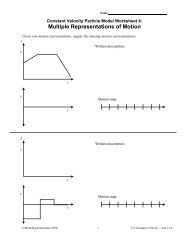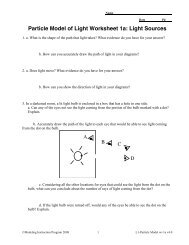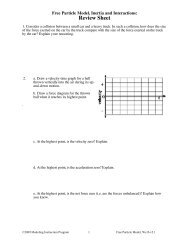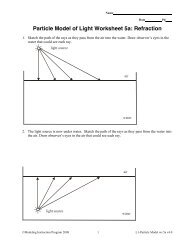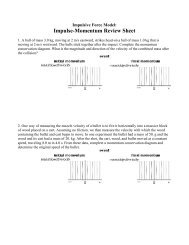Exploring Electric Potential Activity using EM Field - Modeling Physics
Exploring Electric Potential Activity using EM Field - Modeling Physics
Exploring Electric Potential Activity using EM Field - Modeling Physics
Create successful ePaper yourself
Turn your PDF publications into a flip-book with our unique Google optimized e-Paper software.
<strong>Electric</strong> <strong>Potential</strong> Model:<br />
<strong>Exploring</strong> <strong>Electric</strong> <strong>Potential</strong><br />
To Accompany "<strong>EM</strong> <strong>Field</strong>" Software<br />
(See the worksheet on <strong>Field</strong> for suggestions on how to use the <strong>EM</strong> program.)<br />
<strong>Exploring</strong> potential around a point charge<br />
Place a positive "8" charge in the middle of your screen. From the "<strong>Field</strong> and <strong>Potential</strong>" menu,<br />
select "<strong>Potential</strong>."<br />
1. Click your pointer at several positions around the point charge.<br />
a) What do you notice about the value of potential as you move away from the charge<br />
b) Why is only a value given for potential Why isn’t a directional arrow given as well<br />
2. Release the mouse: this will leave a potential value on the screen.<br />
a) How can you create four identical values Test your prediction.<br />
b) What relationship might exist between potential and distance from the point charge Test<br />
your prediction.<br />
c) Erase the potential values. Go now to the "<strong>Field</strong> and <strong>Potential</strong>" menu and select<br />
"Equipotential lines." Click on the screen around the charge to create lines which represent<br />
positions of equal potential.<br />
i - Why are all the lines circular<br />
ii - Where would you find the line representing 0.0 volts<br />
3. Erase the equipotential lines and replace the positive charge with a negative "8" charge.<br />
a) Predict how the values of electric potential around the negative charge will be the same as<br />
those around the positive charge. In what ways would you find them different<br />
To test your prediction, you will have to go back to the "<strong>Field</strong> and <strong>Potential</strong>" menu and select<br />
"<strong>Potential</strong>".<br />
b) How are lines of equal potential around the negative charge different from those around a<br />
positive charge<br />
c) Where does the program assign the line representing 0.0 volts around a negative charge<br />
©<strong>Modeling</strong> Workshop Project 2009 1 E&M Unit 2 – <strong>Exploring</strong> <strong>Potential</strong>
4. Erase the markings on the screens. Place a positive "4" and a negative "4" charge on the screen<br />
about 8 centimeters apart.<br />
a. Use the "<strong>Potential</strong>" values option to determine what the potential is at various locations around<br />
the two charges. After completing your exploration, answer the following questions:<br />
i - At what place or places is the largest positive value of potential found<br />
ii - At what place or places is the largest negative value of potential found<br />
iii - At what place or places is the potential zero<br />
iv - Describe as best you can the general pattern of potential values.<br />
b. Draw lines below representing places of equal potential: you should draw four or five such<br />
lines, including the line representing places where the potential is 0 volts. If you like, use the<br />
"Equipotential" option in the program to help you complete your diagram.<br />
i - Looking at the diagram you have just created, would there be an energy transfer if a<br />
positive charge were moved from point B to point A into or out of the field<br />
ii - On your diagram above, make a heavy line representing a path along which a negative<br />
charge could be move without losing or gaining potential energy; mark this line “Energy<br />
Free Path.”<br />
5. Erase all markings. Leaving the positive "4" charge in place, replace the negative "4" charge<br />
with a second positive "4" charge.<br />
a. Use the "<strong>Potential</strong>" values option to determine values of the potential around the two charges.<br />
After completing your exploration, answer the following questions:<br />
i - Where is the value of potential 0 volts<br />
©<strong>Modeling</strong> Workshop Project 2009 2 E&M Unit 2 – <strong>Exploring</strong> <strong>Potential</strong>
ii - Describe as best you can the general pattern of potential values.<br />
iii - If you placed a small positive charge halfway between the two positive "4" charges, how<br />
would it move<br />
iv - Would a transfer of energy be required to move a small positive charge towards the<br />
positive charges Explain.<br />
v - Would a transfer of energy be required to move a small negative charge towards the<br />
positive charges Explain<br />
b. Draw lines below representing places of equal potential: you should draw four or five such<br />
lines, including the line representing places where the potential is 0 volts. If you like, use the<br />
"Equipotential" option in the program to help you complete your diagram.<br />
©<strong>Modeling</strong> Workshop Project 2009 3 E&M Unit 2 – <strong>Exploring</strong> <strong>Potential</strong>
<strong>Exploring</strong> potential between parallel plates<br />
Open the file “2 plates.emf” Select "Equipotential Lines" from the "<strong>Field</strong> and <strong>Potential</strong>" menu<br />
and determine where the lines of equal potential lie between the two plates. Make a diagram of<br />
your results below:<br />
Answer these questions based upon your explorations:<br />
a) How does the potential vary as you move from the middle of the positive “plate” to the<br />
middle of the negative “plate”<br />
b) Suppose you placed a small positive charge close to the positive “plate” (for example, at<br />
point "Z" on the diagram).<br />
i - Describe the change in potential energy as the charge moves toward the negative “plate”.<br />
ii - Describe the change in kinetic energy as the charge moves toward the negative “plate”.<br />
iii - As the charge moves, is energy transferred into or out of the electric field<br />
©<strong>Modeling</strong> Workshop Project 2009 4 E&M Unit 2 – <strong>Exploring</strong> <strong>Potential</strong>


